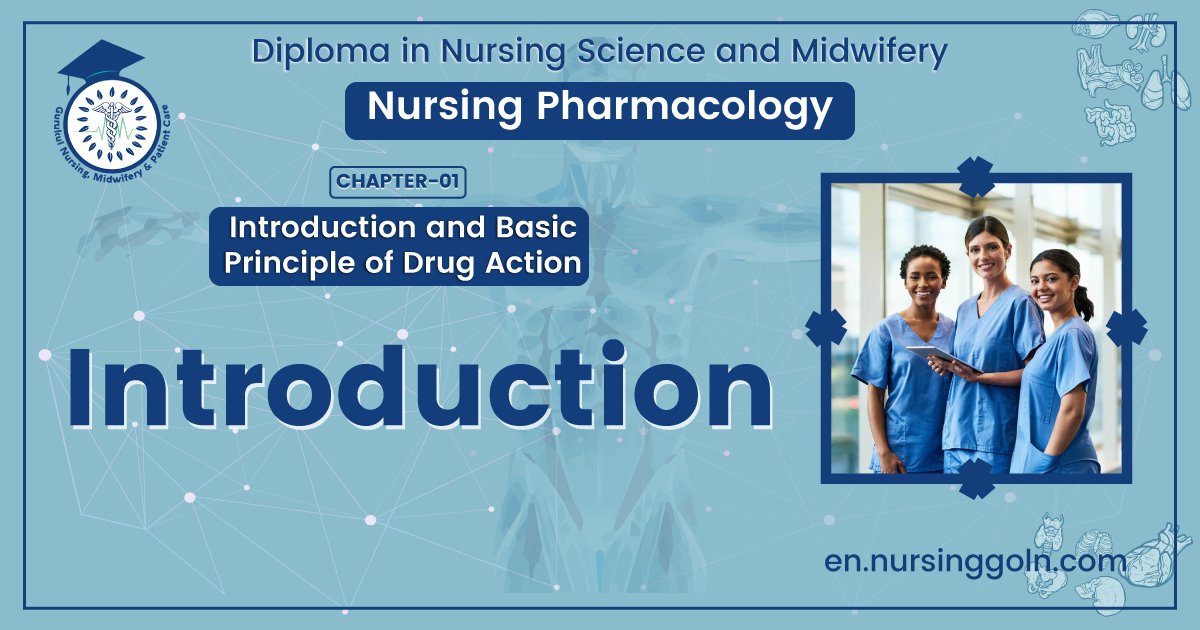Introduction to Pharmacology – This book covers the entire syllabus of “Pharmacology” prescribed by BNMC- for diploma in nursing science & midwifery students. We tried to accommodate the latest information and topics. This book is an examination setup according to the teachers’ lectures and examination questions.
At the end of the book, previous questions are given. We hope in touch with the book students’ knowledge will be upgraded and flourish. The unique way of presentation may make your reading of the book a pleasurable experience.

Introduction to Pharmacology
Pharmacology is derived from the Greek words pharmakon (means drug) & logos (means a study of).
“Pharmacology can be defined as the study of substances that interact with living systems through chemical processes, especially by binding to regulatory molecules and activating or inhibiting normal body processes”.
(Ref-Katzung/14/11)
Or,
“It can be simply defined as the study of interaction of drugs with living organisms”se
Or,
Pharmacology can be defined as a branch of science that includes history, source, physicochemical properties, dosage forms, methods of administration, absorption, distribution, mechanism of action, pharmacological effects, biotransformation, excretion, clinical uses, and adverse effects of drug.

[Ref- Mishbahuddin 5/1]
Definition of Medical Pharmacology
Medical pharmacology (therapeutics) is defined as the science of substances used to prevent, diagnose and treat diseases.
[Ref-Katzung/14/1]
Branches of Pharmacology:
1. Clinical pharma-cology: It is a branch of pharma-cology that deals with the scientific study of drugs in human for their safe and effective use. It has two parts:
a. Pharmacodynamics: This is the branch of pharma-cology that deals with the biochemical and physiological effects of drugs and their mechanism of action.
b. Pharmacokinetics: The study of drug absorption, distribution, metabolism & excretion is called pharmacokinetics.
2. Therapeutics: Therapeutics is a branch of pharma-cology that deals with the use of drugs in the human body to detect, protect, control, and cure diseases,
3. Pharmacy (Pharmaceutics): It is concerned with the preparation, compounding, and dispensing of chemical agents for therapeutic uses. It includes:
a. Pharmacognosy: Deals with the source, identification, isolation, purification, and standardization of drugs.
b. Pharmaceutical chemistry: Deals with the synthesis of new drug
c. Biopharmaceutics: Deals with the formulation of drugs.
4. Toxicology: It is a branch of pharmacology that deals with the study of the adverse poisonous effects of drugs on living systems and their management.
5. Pharmacogenetics; It is the study of the genetic variations that cause differences in drug response among individuals or populations.
6. Immunopharmacology: Deals with the immunological aspects of drug action, including the effects of the drug in the immune response and the development of antibodies in response to the drug.
7. Behavioural pharmacology: Refers to the study of how the drug affects the behavior of a patient.
8. Pharmacoeconomics: This is the study of the cost of medicine taken into account.
9. Pharmacoepidemiology: This is the study of both the beneficial and the adverse effects of a drug on a large number of people.
10. Chemotherapy: It is the branch of pharmacology that deals with the effects of drugs upon microorganisms, parasites and cancer cells.
[Ref- Mishbahuddin 5/3, 4]
Sources of Drug Information:
A. Pharmacopoeia:
- United States Pharmacopoeia.
- British Pharmacopoeia.
- Pharmacopoeia Internationale by WHO etc.
B. Formulary:
- British National Formulary (BNF).
- Bangladesh National Drug Formulary (BDNF) etc.
C. Textbooks:
- Goodman & Gilman’s The Pharmacological Basis of Therapeutics.
- Basic & Clinical Pharmacology (By Bertram G. Katzung) etc.
D. Medical journals:
- New England Journal of Medicine.
- British Medical Journal.
- European journal of pharmacology.
E. Pharmaceuticals companies: But their information sometimes may be biased.
F. Computer based information: Single comprehensive source of drug information. Data base software for pharmacokinetic designing.
G. Unbiased information about drug is proved by:
- Martindale’s Extra Pharmacopoeia.
- American Drug Index.
- WHO drug information
[Ref- Mishbahuddin 5/6-8]

Pharmacopoeia/Drug Compendia:
A book containing a lists of products used in medicine with descriptions, chemical tests for determining identity & purity, & formulas for certain mixtures of these substances. It also generally contains a statement of average dosage
[Ref- Dorland’s dictionary /31/1446]
Read more:
